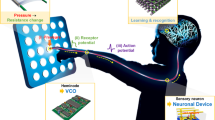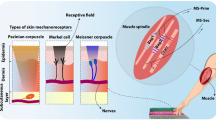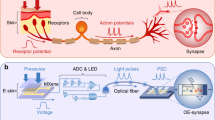Abstract
Humans detect tactile stimuli through a combination of pressure and vibration signals using different types of cutaneous receptor. The development of artificial tactile perception systems is of interest in the development of robotics and prosthetics, and artificial receptors, nerves and skin have been created. However, constructing systems with human-like capabilities remains challenging. Here, we report an artificial neural tactile skin system that mimics the human tactile recognition process using particle-based polymer composite sensors and a signal-converting system. The sensors respond to pressure and vibration selectively, similarly to slow adaptive and fast adaptive mechanoreceptors in human skin, and can generate sensory neuron-like output signal patterns. We show in an ex vivo test that undistorted transmission of the output signals through an afferent tactile mouse nerve fibre is possible, and in an in vivo test that the signals can stimulate a rat motor nerve to induce the contraction of a hindlimb muscle. We use our tactile sensing system to develop an artificial finger that can learn to classify fine and complex textures by integrating the sensor signals with a deep learning technique. The approach can also be used to predict unknown textures on the basis of the trained model.
This is a preview of subscription content, access via your institution
Access options
Access Nature and 54 other Nature Portfolio journals
Get Nature+, our best-value online-access subscription
$29.99 / 30 days
cancel any time
Subscribe to this journal
Receive 12 digital issues and online access to articles
$119.00 per year
only $9.92 per issue
Buy this article
- Purchase on Springer Link
- Instant access to full article PDF
Prices may be subject to local taxes which are calculated during checkout





Similar content being viewed by others
Data availability
The data supporting the findings of this study are provided in the Supplementary Information. Additional relevant data are available from the corresponding author upon reasonable request.
References
Hollins, M. & Risner, S. R. Evidence for the duplex theory of tactile texture perception. Percept. Psychophys. 62, 695–705 (2000).
Chun, S., Hwang, I., Son, W., Chang, J. H. & Park, W. Recognition, classification, and prediction of the tactile sense. Nanoscale 10, 10545–10553 (2018).
Chun, S. et al. Conductive and stretchable adhesive electronics with miniaturized octopus-like suckers against dry/wet skin for biosignal monitoring. Adv. Funct. Mater. 28, 1805224 (2018).
Abraira, V. E. & Ginty, D. D. The sensory neurons of touch. Neuron 79, 618–639 (2013).
Chortos, A., Liu, J. & Bao, Z. Pursuing prosthetic electronic skin. Nat. Mater. 15, 937–950 (2016).
Hou, C., Wang, H., Zhang, Q., Li, Y. & Zhu, M. Highly conductive, flexible, and compressible all-graphene passive electronic skin for sensing human touch. Adv. Mater. 26, 5018–5024 (2014).
Gong, S. et al. A wearable and highly sensitive pressure sensor with ultrathin gold nanowires. Nat. Commun. 5, 3132 (2014).
Mannsfeld, S. C. B. et al. Highly sensitive flexible pressure sensors with microstructured rubber dielectric layers. Nat. Mater. 9, 859–864 (2010).
Pan, L. et al. An ultra-sensitive resistive pressure sensor based on hollow-sphere microstructure induced elasticity in conducting polymer film. Nat. Commun. 5, 3002 (2014).
Someya, T. et al. Conformable, flexible, large-area networks of pressure and thermal sensors with organic transistor active matrixes. Proc. Natl Acad. Sci. USA 102, 12321–12325 (2005).
Wang, C. et al. User-interactive electronic skin for instantaneous pressure visualization. Nat. Mater. 12, 899–904 (2013).
Sekitani, T. et al. Organic nonvolatile memory transistors for flexible sensor arrays. Science 326, 1516–1519 (2009).
Lee, S. et al. A transparent bending-insensitive pressure sensor. Nat. Nanotechnol. 11, 472–478 (2016).
Park, J., Kim, M., Lee, Y., Lee, H. S. & Ko, H. Fingertip skin-inspired microstructured ferroelectric skins discriminate static/dynamic pressure and temperature stimuli. Sci. Adv. 1, e1500661 (2015).
Chen, X., Xu, S., Yao, N. & Shi, Y. 1.6 V nanogenerator for mechanical energy harvesting using PZT nanofibers. Nano Lett. 10, 2133–2137 (2010).
Chen, J. et al. Harmonic-resonator-based triboelectric nanogenerator as a sustainable power source and a self-powered active vibration sensor. Adv. Mater. 25, 6094–6099 (2013).
Lee, W. W. et al. A neuro-inspired artificial peripheral nervous system for scalable electronic skins. Sci. Robot. 4, eaax2198 (2019).
Schwartz, G. et al. Flexible polymer transistors with high pressure sensitivity for application in electronic skin and health monitoring. Nat. Commun. 4, 1859 (2013).
Chun, K. Y., Son, Y. J., Jeon, E. S. & Lee, S. A self-powered sensor mimicking slow- and fast-adapting cutaneous mechanoreceptors. Adv. Mater. 30, 1706299 (2018).
Jin, M. L. et al. An ultrasensitive, visco-poroelastic artificial mechanotransducer skin inspired by Piezo2 protein in mammalian Merkel cells. Adv. Mater. 29, 1605973 (2017).
Kim, S. Y. et al. Highly sensitive and multimodal all-carbon skin sensors capable of simultaneously detecting tactile and biological stimuli. Adv. Mater. 27, 4178–4185 (2015).
Drotlef, D. M., Amjadi, M., Yunusa, M. & Sitti, M. Bioinspired composite microfibers for skin adhesion and signal amplification of wearable sensors. Adv. Mater. 29, 1701353 (2017).
Gerratt, A. P., Michaud, H. O. & Lacour, S. P. Elastomeric electronic skin for prosthetic tactile sensation. Adv. Funct. Mater. 25, 2287–2295 (2015).
Nunez, C. G., Navaraj, W. T., Polat, E. O. & Dahiya, R. Energy-autonomous, flexible, and transparent tactile skin. Adv. Funct. Mater. 27, 1606287 (2017).
Ha, M., Park, J., Lee, Y. & Ko, H. Triboelectric generators and sensors for self-powered wearable electronics. ACS Nano 9, 3421–3427 (2015).
Liao, Z. et al. A tactile sensor translating texture and sliding motion information into electrical pulses. Nanoscale 7, 10801–10806 (2015).
Chun, S., Kim, Y., Oh, H. S., Bae, G. & Park, W. A highly sensitive pressure sensor using a double-layered graphene structure for tactile sensing. Nanoscale 7, 11652–11659 (2015).
Tee, B. C. K. et al. A skin-inspired organic digital mechanoreceptor. Science 350, 313–316 (2015).
Kim, Y. et al. A bioinspired flexible organic artificial afferent nerve. Science 360, 998–1003 (2018).
Rongala, U. B., Mazzoni, A. & Oddo, C. M. Neuromorphic artificial touch for categorization of naturalistic textures. IEEE Trans. Neural Netw. Learn. Syst. 28, 819–828 (2017).
Wu, Y. et al. A skin-inspired tactile sensor for smart prosthetics. Sci. Robot. 3, eaat0429 (2018).
Chun, S. et al. A tactile sensor using a graphene film formed by the reduced graphene oxide flakes and its detection of surface morphology. Carbon 94, 982–987 (2015).
Hu, D. et al. Strategies to achieve high performance piezoelectric nanogenerators. Nano Energy 55, 288–304 (2019).
Park, J. et al. Giant tunneling piezoresistance of composite elastomers with interlocked microdome arrays for ultrasensitive and multi-modal electronic skin. ACS Nano 8, 4689–4697 (2014).
Chun, S. et al. Bioinspired hairy skin electronics for detecting the direction and incident angle of airflow. ACS Appl. Mater. Interfaces 11, 13608–13615 (2019).
Zhang, G. et al. Novel piezoelectric paper-based flexible nanogenerators composed of BaTiO3 nanoparticles and bacterial cellulose. Adv. Sci. 3, 1500257 (2016).
Lee, M. et al. A hybrid piezoelectric structure for wearable nanogenerators. Adv. Mater. 24, 1759–1764 (2012).
Chun, S., Hong, A., Choi, Y., Ha, C. & Park, W. A tactile sensor using a conductive graphene–sponge composite. Nanoscale 8, 9185–9192 (2016).
Noorsal, E. et al. A neural stimulator frontend with high-voltage compliance and programmable pulse shape for epiretinal implants. IEEE J. Solid-State Circuits 47, 244–256 (2012).
Williams, I. & Constandinou, T. G. An energy-efficient, dynamic voltage scaling neural stimulator for a proprioceptive prosthesis. IEEE Trans. Biomed. Circuits Syst. 7, 129–139 (2013).
Thurgood, B. K., Warren, D. J., Ledbetter, N. M., Clark, G. A. & Harrison, R. R. A wireless integrated circuit for 100-channel charge-balanced neural stimulation. IEEE Trans. Biomed. Circuits Syst. 3, 405–414 (2009).
National Research Council Guide for the Care and Use of Laboratory Animals (National Academies Press, 2010).
Zimmermann, K. et al. Phenotyping sensory nerve endings in vitro in the mouse. Nat. Protoc. 4, 174–196 (2009).
Jang, J. H. et al. Nociceptive sensitization by complement C5a and C3a in mouse. Pain 148, 343–352 (2010).
Shimokawa, T., Koyama, S. & Shinomoto, S. A characterization of the time-rescaled gamma process as a model for spike trains. J. Comp. Neurosci. 29, 183–191 (2009).
Song, K. I., Chu, J. U., Park, S. E., Hwang, D. & Youn, I. Ankle-angle estimation from blind source separated afferent activity in the sciatic nerve for closed-loop functional neuromuscular stimulation system. IEEE Trans. Biomed. Eng. 64, 834–843 (2017).
Acknowledgements
This study was supported by the Basic Science Research Program through the National Research Foundation of Korea (NRF grants 2020R1C1C1007589, 2018R1A6A3A01011866 and 2019M3C1B8077201), a Korea Medical Device Development Fund grant funded by the Korean government (Ministry of Science and ICT, Ministry of Trade, Industry and Energy, Ministry of Health & Welfare, Ministry of Food and Drug Safety) (NTIS no. 9991006805), the National R&D Program through the National Research Foundation of Korea (NRF) funded by the Ministry of Science and ICT (2021M3H4A1A03048648 and 2021M3F3A2A01037365), the Smart Project Program through the KAIST–Khalifa Joint Research Center (KK-JRC), the KAIST College of Engineering Global Initiative Convergence Research Program and the KAIST Post-AI Research Project. This work was supported by a Korea University Grant.
Author information
Authors and Affiliations
Contributions
S.C. and W.P. conceived this work and developed the design of the human-like neural T-skin system. S.C. and J.-S.K fabricated the T-skin device and analysed its properties. G.L. analysed the distribution and composition of particles. S.C., C.P. and W.P. measured and analysed tactile sensing properties. J.-S.K., Y.Y. and B.-D.C. designed and fabricated a neural stimulator. S.J.J., Y.C. and D.J. conducted ex vivo experiments and databased the SA and FA response patterns. J.K. and S.P.K. made the mathematical function from firing activity of a single-fibre recording. S.P., D.S., K.S.N., K.-I.S., I.Y. and Y.J. conducted the biological experiments for application of the T-skin system. S.C. conducted the deep learning process. All authors analysed the data, and S.C., S.P. and J.-S.K. wrote the paper. All authors reviewed the manuscript and provided feedback.
Corresponding authors
Ethics declarations
Competing interests
The authors declare no competing interests.
Additional information
Peer review information Nature Electronics thanks John Ho, Bozhi Tian and Gordon Cheng for their contribution to the peer review of this work.
Publisher’s note Springer Nature remains neutral with regard to jurisdictional claims in published maps and institutional affiliations.
Supplementary information
Supplementary Information
Supplementary text, Figs. 1–30 and Table 1.
Supplementary Video 1
Demonstration of human-like artificial neural T-skin system, which includes a T-skin device with sensor board, a neural stimulator for converting to neural signals, the stimulation system of mouse skin and normal transmission in neurons.
Supplementary Video 2
In vivo response test for T-skin system. A vibration with a certain frequency (1, 2, 10, 20, 100, 500 Hz) is applied to the sensor and the contraction of the hindlimb muscle of the rat is investigated.
Supplementary Data 1
Zip file including raw data of the experiments in spreadsheet form.
Rights and permissions
About this article
Cite this article
Chun, S., Kim, JS., Yoo, Y. et al. An artificial neural tactile sensing system. Nat Electron 4, 429–438 (2021). https://doi.org/10.1038/s41928-021-00585-x
Received:
Accepted:
Published:
Issue Date:
DOI: https://doi.org/10.1038/s41928-021-00585-x
This article is cited by
-
Porous nanocomposites with enhanced intrinsic piezoresistive sensitivity for bioinspired multimodal tactile sensors
Microsystems & Nanoengineering (2024)
-
Neuromorphic antennal sensory system
Nature Communications (2024)
-
Triboelectric micro-flexure-sensitive fiber electronics
Nature Communications (2024)
-
Intelligent Recognition Using Ultralight Multifunctional Nano-Layered Carbon Aerogel Sensors with Human-Like Tactile Perception
Nano-Micro Letters (2024)
-
Bionic artificial skin with a fully implantable wireless tactile sensory system for wound healing and restoring skin tactile function
Nature Communications (2024)



